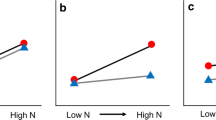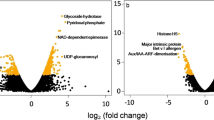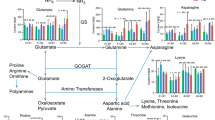Abstract
Main conclusion
High expressions of nitrate use and photosynthesis-related transcripts contribute to the stronger plasticity to high nitrate for the invader relative to its native congener, which may be driven by hormones.
Abstract
Strong phenotypic plasticity is often considered as one of the main mechanisms underlying exotic plant invasions. However, few studies have been conducted to investigate the related molecular mechanisms. Here, we determined the differences in the plastic responses to high nitrate between the invasive plant X. strumarium and its native congener, and the molecular bases by transcriptome analysis and quantitative real-time PCR validation. Our results showed that the invader had higher plasticity of growth, nitrogen accumulation and photosynthesis in responses to high nitrate than its native congener. Compared with its congener, more N utilization-related transcripts, including nitrate transporter 1/peptide transporter family 6.2 and nitrate reductase 1, were induced by high nitrate in the root of X. strumarium, improving its N utilization ability. More transcripts coding for photosynthetic antenna proteins were also induced by high nitrate in the shoot of X. strumarium, enhancing its photosynthesis. Hormones may be involved in the regulation of the plastic responses to high nitrate in the two species. Our study contributes to understanding the molecular mechanisms underlying the stronger plasticity of the invader in responses to high nitrate, and the potential function of plant hormones in these processes, providing bases for precise control of invasive plants using modern molecular techniques.









Similar content being viewed by others
Data availability
The data sets generated during and/or analysed during the current study are available from the corresponding author on reasonable request. RNA sequencing used in this study are stored in https://dataview.ncbi.nlm.nih.gov/object/PRJNA863412?reviewer=dv32r49hisb0ugi1siv1771ed4.
Abbreviations
- DETs:
-
Differently expressed transcripts
- GLN:
-
Glutamine synthetase
- GOGAT:
-
Glutamate synthase
- NIA:
-
Nitrate reductase
- NIR:
-
Nitrite reductase
- NPF:
-
Nitrate transporter 1/peptide transporter family
- NRT2:
-
Nitrate transporter 2
References
Bao A, Liang Z, Zhao Z, Cai H (2015) Overexpressing of OsAMT1-3, a high affinity ammonium transporter gene, modifies rice growth and carbon-nitrogen metabolic status. Int J Mol Sci 16:9037–9063
Chen W-B, Chen B-M (2019) Considering the preferences for nitrogen forms by invasive plants: a case study from a hydroponic culture experiment. Weed Res 59:49–57
Chen J-G, Cheng S-H, Cao W, Zhou X (1998) Involvement of endogenous plant hormones in the effect of mixed nitrogen source on growth and tillering of wheat. J Plant Nutr 21:87–97
Davidson AM, Jennions M, Nicotra AB (2011) Do invasive species show higher phenotypic plasticity than native species and if so, is it adaptive? A meta-analysis. Ecol Lett 14:419–431
Enders M, Havemann F, Ruland F et al (2020) A conceptual map of invasion biology: integrating hypotheses into a consensus network. Global Ecol Biogeogr 29:978–991
Feng Y-L (2020) Invasive plants in northeast China. Science Publication House, Beijing
Feng Y-L, Auge H, Eberling SK (2007) Invasive Buddleja davidii allocates more nitrogen to its photosynthetic machinery than five native woody species. Oecologia 153:501–510
Feng Y-L, Lei Y-B, Wang R-F et al (2009) Evolutionary tradeoffs for nitrogen allocation to photosynthesis versus cell walls in an invasive plant. Proc Natl Acad Sci USA 106:1853–1856
Honda S, Ohkubo S, San NS et al (2021) Maintaining higher leaf photosynthesis after heading stage could promote biomass accumulation in rice. Sci Rep 11:7579
Hu B, Wang W, Ou S et al (2015) Variation in NRT1.1B contributes to nitrate-use divergence between rice subspecies. Nat Genet 47:834–838
Huang K, Kong D-L, Lu X-R, Feng W-W, Liu M-C, Feng Y-L (2020) Lesser leaf herbivore damage and structural defenses and greater nutrient concentrations for invasive alien plants: evidence from 47 pairs of invasive and non-invasive plants. Sci Total Environ 723:137829
Huangfu C-H, Li H, Chen X, Liu H, Wang H, Yang D (2016) Response of an invasive plant, Flaveria bidentis, to nitrogen addition: a test of form-preference uptake. Biol Invasions 18:3365–3380
Hulme PE (2009) Trade, transport and trouble: managing invasive species pathways in an era of globalization. J Appl Ecol 46:10–18
Jackson LE, Burger M, Cavagnaro TR (2008) Roots nitrogen transformations, and ecosystem services. Annu Rev Plant Biol 59:341–363
Krouk G (2016) Hormones and nitrate: a two-way connection. Plant Mol Biol 91:599–606
Krouk G, Mirowski P, LeCun Y, Shasha DE, Coruzzi GM (2010) Predictive network modeling of the high-resolution dynamic plant transcriptome in response to nitrate. Genome Biol 11:R123
Lafon-Placette C, Le Gac AL, Chauveau D et al (2018) Changes in the epigenome and transcriptome of the poplar shoot apical meristem in response to water availability affect preferentially hormone pathways. J Exp Bot 69:537–551
Lea PJ, Morot-Gaudry JF (2001) Plant nitrogen. Springer, New York
Lei Y-B, Wang W-B, Feng Y-L, Zheng Y-L, Gong H-D (2012) Synergistic interactions of CO2 enrichment and nitrogen deposition promote growth and ecophysiological advantages of invading Eupatorium adenophorum in southwest China. Planta 236:1205–1213
Li H, Hu B, Chu C (2017) Nitrogen use efficiency in crops: lessons from Arabidopsis and rice. J Exp Bot 68:2477–2488
Liu M-C, Kong D-L, Lu X-R et al (2017) Higher photosynthesis, nutrient- and energy-use efficiencies contribute to invasiveness of exotic plants in a nutrient poor habitat in northeast China. Physiol Plant 160:373–382
Liu M-C, Dong T-F, Feng W-W et al (2022) Leaf trait differences between 97 pairs of invasive and native plants across China: effects of identities of both the invasive and native species. NeoBiota 71:1–22
Lu X-R, Feng W-W, Wang W-J et al (2022) AMF colonization and community of a temperate invader and co-occurring natives grown under different CO2 concentrations for three years. J Plant Ecol 15:437–449
Luo J-J, Gao Y-M, Feng W-W et al (2022) Stronger ability to absorb nitrate and associated transporters in the invasive plant Xanthium strumarium compared with its native congener. Environ Exp Bot 198:104851
Morere-Le Paven MC, Viau L, Hamon A et al (2011) Characterization of a dual-affinity nitrate transporter MtNRT1.3 in the model legume Medicago truncatula. J Exp Bot 62:5595–5605
O’Brien JA, Vega A, Bouguyon E et al (2016) Nitrate transport, sensing, and responses in plants. Mol Plant 9:837–856
Pigliucci M, Murren CJ, Schlichting CD (2006) Phenotypic plasticity and evolution by genetic assimilation. J Exp Biol 209:2362–2367
Pysek P, Hulme PE, Simberloff D et al (2020) Scientists’ warning on invasive alien species. Biol Rev 95:1511–1534
Rahayu YS, Walch-Liu P, Neumann G, Romheld V, von Wiren N, Bangerth F (2005) Root-derived cytokinins as long-distance signals for NO3- induced stimulation of leaf growth. J Exp Bot 56:1143–1152
Rao LE, Allen EB (2010) Combined effects of precipitation and nitrogen deposition on native and invasive winter annual production in California deserts. Oecologia 162:1035–1046
Richards CL, Bossdorf O, Muth NZ, Gurevitch J, Pigliucci M (2006) Jack of all trades, master of some? On the role of phenotypic plasticity in plant invasions. Ecol Lett 9:981–993
Sakakibara H, Takei K, Hirose N (2006) Interactions between nitrogen and cytokinin in the regulation of metabolism and development. Trends Plant Sci 11:440–448
Seebens H, Blackburn TM, Dyer EE et al (2017) No saturation in the accumulation of alien species worldwide. Nat Commun 8:14435–14435
Seebens H, Bacher S, Blackburn TM et al (2021) Projecting the continental accumulation of alien species through to 2050. Global Change Biol 27:970–982
Siemann E, Rogers WE (2003) Changes in light and nitrogen availability under pioneer trees may indirectly facilitate tree invasions of grasslands. J Ecol 91:923–931
Sun S-M, Chen J-X, Feng W-W et al (2021) Plant strategies for nitrogen acquisition and their effects on exotic plant invasions. Biodiversity Sci 29:72–80
Tian Q-Y, Sun P, Zhang W-H (2009) Ethylene is involved in nitrate-dependent root growth and branching in Arabidopsis thaliana. New Phytol 184:918–931
Tomassen HBM, Smolders AJP, Limpens J, Lamers LPM, Roelofs JGM (2004) Expansion of invasive species on ombrotrophic bogs: desiccation or high N deposition? J Appl Ecol 41:139–150
Urriola J, Rathore KS (2015) Overexpression of a glutamine synthetase gene affects growth and development in sorghum. Transgenic Res 24:397–407
Valladares F, Sanchez-Gomez D, Zavala MA (2006) Quantitative estimation of phenotypic plasticity: bridging the gap between the evolutionary concept and its ecological applications. J Ecol 94:1103–1116
Vesga P, Flury P, Vacheron J, Keel C, Croll D, Maurhofer M (2020) Transcriptome plasticity underlying plant root colonization and insect invasion by Pseudomonas protegens. ISME J 14:2766–2782
Wang T-Y, Luan J-B (2023) Silencing horizontally transferred genes for the control of the whitefly Bemisia tabaci. J Pest Sci 96:195–208
Wang S, Feng W-W, Huang K et al (2022a) Inherent conflicts between reaction norm and plasticity indices when comparing phenotypic plasticity between species: a theoretical and empirical test. Oecologia 198:593–603
Wang S, Chen J-X, Liu M-C, Wang W-B, Feng Y-L (2022b) Phenotypic plasticity and exotic plant invasions: effects of soil nutrients, species nutrient requirements, and types of traits. Physiol Plant 174:e13637
Wen Z-Y, Tyerman SD, Dechorgnat J, Ovchinnikova E, Dhugga KS, Kaiser BN (2017) Maize NPF6 proteins are homologs of Arabidopsis CHL1 that are selective for both nitrate and chloride. Plant Cell 29:2581–2596
Xu G-H, Fan X-R, Miller AJ (2012) Plant nitrogen assimilation and use efficiency. Annu Rev Plant Biol 63:153–182
Yu G-R, Jia Y-L, He N-P et al (2019) Stabilization of atmospheric nitrogen deposition in China over the past decade. Nat Geosci 12:424–429
Zhang C, Lu W-H, Yang Y, Shen Z-G, Ma J-F, Zheng L-Q (2018) OsYSL16 is required for preferential Cu distribution to floral organs in rice. Plant Cell Physiol 59:2039–2051
Zhang C, Luo J-J, Zuo J-B et al (2022) Transcripts related with ammonium use and effects of gibberellin on expressions of the transcripts responding to ammonium in two invasive and native Xanthium species. Front Plant Sci 13:1035137
Zhao Y-Z, Liu M-C, Feng Y-L et al (2020) Release from below- and aboveground natural enemies contributes to invasion success of a temperate invader. Plant Soil 452:19–28
Zheng Y-L, Feng Y-L, Liu W-X, Liao Z-Y (2009) Growth, biomass allocation, morphology and photosynthesis of invasive Eupatorium adenophorum and its native congeners grown at four irradiances. Plant Ecol 203:263–271
Zheng Y-L, Feng Y-L, Zhang L-K et al (2015) Integrating novel chemical weapons and evolutionarily increased competitive ability in success of a tropical invader. New Phytol 205:1350–1359
Zou N, Shi W, Hou L et al (2020) Superior growth, N uptake and NH4+ tolerance in the giant bamboo Phyllostachys edulis over the broad-leaved tree Castanopsis fargesii at elevated NH4+ may underlie community succession and favor the expansion of bamboo. Tree Physiol 40:1606–1622
Funding
This study was funded by National Natural Science Foundation of China (31971557, 32001235 and 32171666).
Author information
Authors and Affiliations
Corresponding author
Ethics declarations
Conflict of interest
The authors declare that they have no conflict of interest.
Additional information
Communicated by Dorothea Bartels.
Publisher's Note
Springer Nature remains neutral with regard to jurisdictional claims in published maps and institutional affiliations.
Supplementary Information
Below is the link to the electronic supplementary material.
Rights and permissions
Springer Nature or its licensor (e.g. a society or other partner) holds exclusive rights to this article under a publishing agreement with the author(s) or other rightsholder(s); author self-archiving of the accepted manuscript version of this article is solely governed by the terms of such publishing agreement and applicable law.
About this article
Cite this article
Zhang, C., Wang, ST., Li, JZ. et al. Molecular bases for the stronger plastic response to high nitrate in the invasive plant Xanthium strumarium compared with its native congener. Planta 258, 61 (2023). https://doi.org/10.1007/s00425-023-04220-1
Received:
Accepted:
Published:
DOI: https://doi.org/10.1007/s00425-023-04220-1




